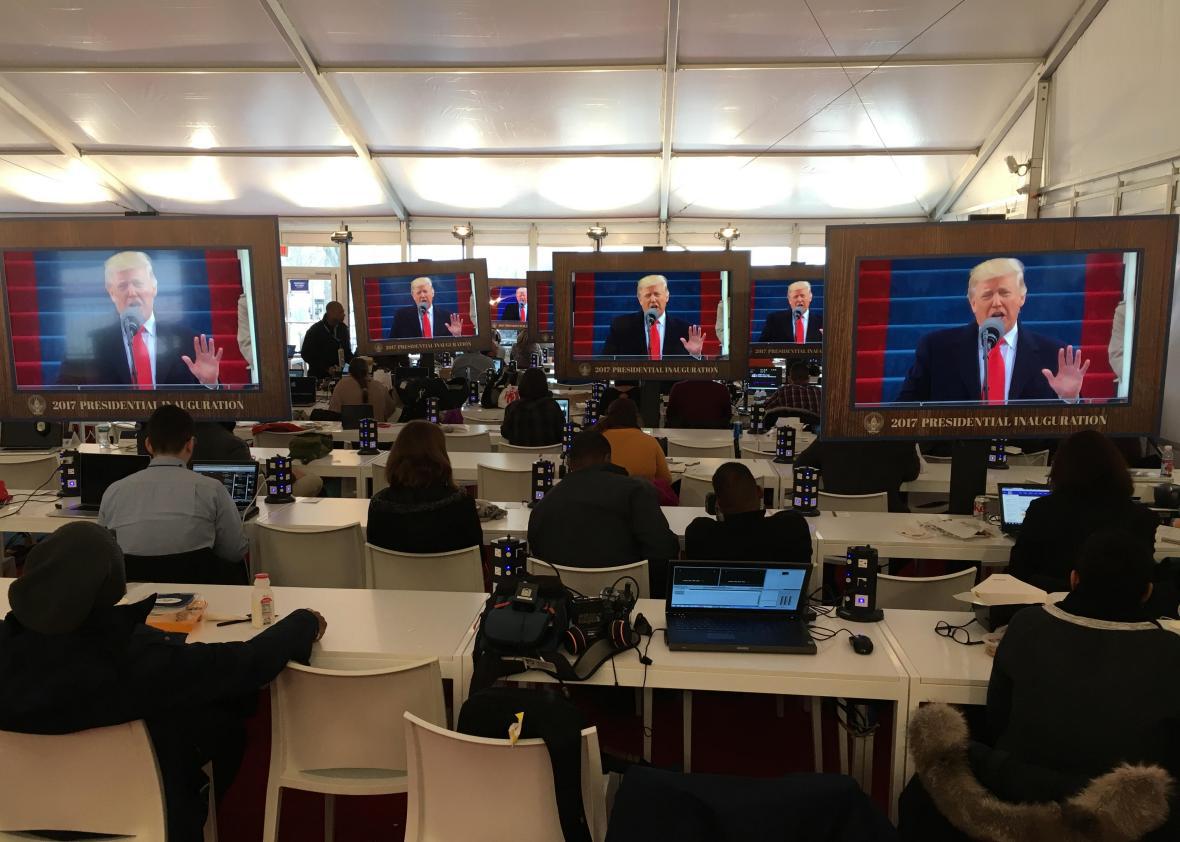Here’s the paradoxical thing about covering big news events like a presidential inauguration: Every journalist wants to be there, but as soon as you get there, you realize that there’s not much to do. It’s a staged, tightly controlled event. You can’t get anywhere near the newsmakers. If anything big happens, everyone will learn about it at roughly the same time. There are no scoops to be had. There are no reputations to be made.
So you don’t go cover the inauguration to break news. You go to flesh out the story. The reason to be on hand for a presidential inauguration, as opposed to covering it from afar, is to help fill in the bits and pieces that will be omitted from the administration’s version of events; the color that enlivens the official picture. Donald J. Trump was inaugurated Friday as president of the United States; that’s what happened, and everyone knows it, and on-the-ground reporters can’t really add all that much value to that part of the story. The way in which it happened, though? That’s the story you come to cover.
I spent the morning and afternoon watching the media cover Trump’s inauguration, and from my vantage most of the credentialed journalists had come to bear witness in their own way. They were here to explain not how this had happened, but to document how it was happening: the mood and composition of the crowd, the energy with which the ceremonies were received. I didn’t see any of the finished products that my colleagues aired or published. Maybe they sucked, I don’t know. But people seemed to be taking their jobs seriously, which isn’t always the case at staged political events.
The Press Filing Center comprised two big white tents with seating for about 500 working journalists. Emphasis on working: inside the tent, people were cutting footage together, editing audio, dumping their notes, uploading blog posts. This was assuredly not the case when I covered the Republican National Convention in July. There, my seating area was half-filled with partisan bloggers who couldn’t stop themselves from cheering for many of the speeches. Friday, though, everyone was here to work, and it felt very out of place when the guy behind me briefly started clapping when Trump was first announced.
Trump needed all the applause he could get Friday. Here’s an uncomfortable truth that the new president will be loath to admit: There were not very many people on hand to see him sworn in. We’ll see what the official count says, but from my vantage it certainly seemed like there were fewer than 100,000 people on the Mall. A lot of them were teenagers and young adults, there with school groups, tour groups, and the Envision Impact Series Presidential Inauguration Leadership Summit. A lot of them were not Trump supporters at all; I’d say about 1 in 10 attendees had come to (silently) protest the inauguration. Right in front of the Capitol, the Mall was filled with people, but west of the National Gallery it was almost empty. It was as if all of the deplorables had overslept.
The people who were there were generally subdued. While protests erupted in the streets outside of the secure perimeter, inside the perimeter comity reigned. I interviewed two NPR staffers who were taking a breather before heading back into downtown D.C. They both agreed that the attendees had been surprisingly civil: Most people were willing to be interviewed, they all seemed surprisingly respectful of each other, there wasn’t much hostility. This was my experience, too. I spoke to one Trump supporter who was wearing a homemade pro-Trump T-shirt with a conspicuous black bar on the back. “The black bar used to say ‘Lock Her Up,’ but I crossed it out [for the inauguration], because I didn’t think it was appropriate,” he said.
Everyone was pretty calm, except for the president. Trump’s belligerent inaugural address was received in near silence in the press area, though it seemed less like respectful silence than like “this fucking guy” silence. Once the ceremony concluded, the Mall emptied out in a hurry, with attendees presumably eager to snag a good vantage point for the upcoming inaugural parade. I caught up with some journalists who lagged behind and asked them their thoughts on the day. “The whole thing was really kind of … damp,” said freelance photographer Dermot Tatlow. “It felt very quiet.” Tatlow covered the Trump campaign last year, and he noted that the Mall on Friday felt much less charged than a typical Trump campaign event. He would not speculate on why that was, but perhaps it had something to do with the presence of so many attendees who had come to protest. “I got nice pictures of people just crying,” Tatlow said. “Crying with sadness.”
Out on the streets of D.C., riots commenced. The police launched tear-gas canisters at protesters. The media are here to bear witness to events like these, too—to report that they happened, and how they happened, and provide a fully documented counter-narrative to the official story. Because the official story will be wrong. Trump’s inauguration wasn’t celebrated so much as it was borne in confused silence—by his supporters, who are unaccustomed to winning, and by his detractors, who know full well how much we have lost.
